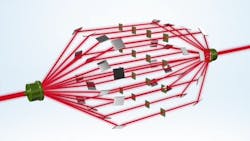Start-up Optalysys aims to demo gigaFLOPS-scale optical processor in January 2015
| Still from video below. (Credit: Optalysys) |
Optalysys (Pontefract, England), a spin-off from Cambridge University (Cambridge, England), has declared that it is only months away from launching a prototype optical processor operating at 1.32 billion floating-point operations per second (gigaFLOPS) with the potential to deliver exascale levels of processing power on a standard-sized desktop computer.
GigaFLOPS in proof-of-concept stage
The company aims to demonstrate its prototype, which it says meets NASA Technology Readiness Level 4, in January of 2015. Though currently only at the proof-of-concept stage, the processor is expected by Optalysys to run at 340 gigaFLOPS or more by 2020.
"Optalysys' technology applies the principles of diffractive and Fourier optics to calculate the same processor intensive mathematical functions used in CFD (computational fluid dynamics) and pattern recognition," says NIck New, the company's founder and CEO. "Using low-power lasers and high-resolution liquid-crystal microdisplays, calculations are performed in parallel at the speed of light." In essence, many parallel laser beams derived from a single laser pass through many microdisplays, each creating an interference pattern for each beam; those patterns are coherently combined and then read out by a final image sensor. Image-processing calculations then provide the answer.
Optalysys says the technology has the potential to deliver several quintillion floating point operations per second (exaFLOPs) with an estimated running cost of £2100 (U.S. $3525) per year.
In comparison, the world's fastest supercomputer, the $320 million Tianhe-2 manufactured by China's National University of Defence Technology, and which can achieve 33.86 petaFLOPS (or 33.86 quadrillion FLOPS), costs $21 million per year to run.
| This video from Optalysys has a somewhat elementary explanation of how its optical-processing technology works. The narrator is Heinz Wolff, professor emeritus of bioengineering at Brunel University (Uxbridge, England). (Credit: Optalysys) |
More FLOPS coming
"We are currently developing two products, a 'big data' analysis system and an optical solver supercomputer, both of which are expected to be launched in 2017," says New. "The analysis unit is designed to work alongside existing supercomputers to provide advanced data-analysis capability. Its initial specification will be 1.32 petaFLOPs, increasing to more than 300 petaFLOPs by 2020. The Optalysys Optical Solver Supercomputer will initially operate at a speed in excess of 9 petaFLOPs, increasing to 17.1 exaFLOPs by 2020."
Optalysys was founded in 2013 by Nick New and James Duez. New developed the forerunner to the company's technology while carrying out Ph.D. research at Cambridge University. Optalysys has several patents covering its technology.
Source: http://www.optalysys.com/blog/light-speed-computing-now-only-months-away/

